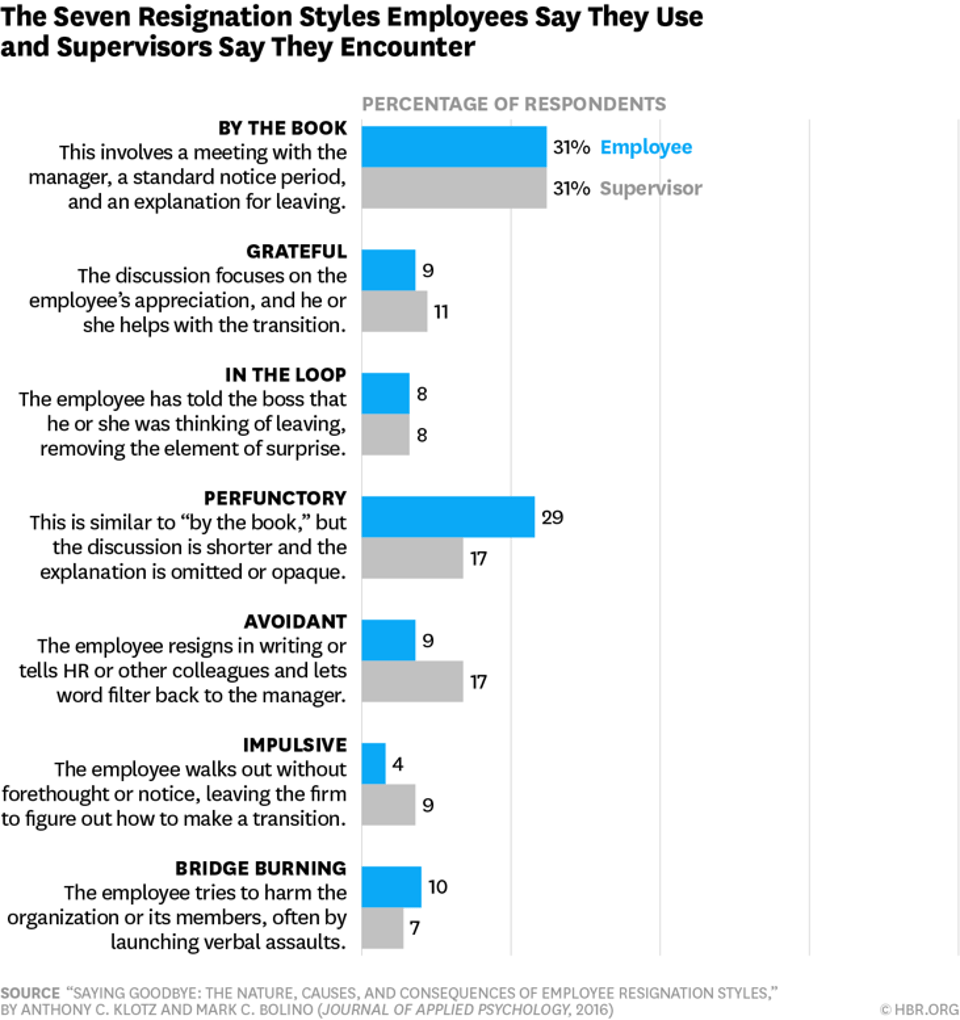
This Tool Works! Using Effective Sales Meetings to Create Massive Momentum
August 14, 2017
Derailed By Distractions? How To Get And Stay Focused Now
September 5, 2017
*As originally seen on Forbes.com
Is there a correlation between the style in which someone quits and the organization itself? A study conducted by Anthony Klotz, Oregon State University College of Business and Mark Bolino, University of Oklahoma Price College of Business discovered the 7 ways that people quit and that a connection may exist.
Let’s take a look at the 7 ways that talent quits and what a leader can do to not only increase retention, but if a person must leave, how to keep them in the categories of 1, 2 and 3.

7 Ways People Quit
- By The Book: 31% quit by having face to face conversations, combined with a letter of resignation that states the exact reason they are leaving along with a notice period.
- Grateful: 9% were positive and willing to have their departure from the organization be painless for their leader and their team.
- In The Loop: 8% actually had the supervisor/leader ‘in the loop’ with the resignation.
- Perfunctory: 29% will have a face to face conversation, give a letter of resignation and a notice period but won’t elaborate on the specific reasons they are quitting.
- Avoidant: 9% kept contact with the leader to an absolute minimum and involved bringing in a third party like HR or ducked out by sending in their resignation over the weekend as opposed to face to face conversations.
- Impulsive: 4% will reach a breaking point without having a conversation at all, there is no notice, no letter or resignation and certainly no willingness to have the transition period be as painless as possible for everyone involved.
- Bridge Burning: 10% will quit not only without any notice, but they want to make sure that their leader and/or organization know that they are extremely upset and why. Emotions run high and both parties lose.
There are two key points that should be examined. First, your talent has made a decision to leave. Can they be retained? Second, your talent will make a decision regarding how they will leave. Can leadership impact how they will choose to leave?
Retain Your Talent
All too often leaders don’t create and foster an environment where talent feels comfortable or confident enough to stand out. It’s easier to blend in with the crowd versus stand out and be seen.
These individuals will see and feel the benefits they bring to the company. Talent that thrives:
- Feel deeply connected to the company’s mission, vision, values and emulate those elements on a daily basis
- Display accountability
- Deliver consistent high quality results
In previous blogs we have discussed how to foster and nurture an environment where your talent will get and stay engaged. These tools will help you form an action plan that you can start implementing today to retain these individuals:
- Learn what your team members crave at a primal and neurological level— and give it to them
- Create a culture that allows team members to rise up and stand out
- Shift their brain from Critter State to Smart State
- Learn how to shift your leadership stance
- Learn how to keep your cool when under pressure
Prevent Drama Filled Exits
If more drama filled exits are occurring, it may be time to examine the underlying issues. In the case of Impulsively Quits or Burns Bridges, it’s not surprising that research showed those individuals may be experiencing higher levels of abuse from their leaders or they may ‘feel’ that they were treated unfairly. For these individuals, leaving in any other manner except one that is high-emotion isn’t an option. By working on creating and sustaining a workplace culture where team members are invested in their role and the success of the business, if the time comes that they must exit, the probability of them staying within the categories of 1, 2 and 3 increases.
In some cases exiting is unavoidable. They may be moving, deciding to take a different direction in their career or they simply do not want to work for your organization anymore. In these cases, how can we make this process as seamless and positive as possible for both parties?
Compassion & Communication
If both parties add compassion and communication, a win-win is created. The person leaving may decide to stay. If the circumstances surrounding their exit are unavoidable they will do all that they can to make this transition process a positive experience for everyone. When the leader holds the person exiting in a place of compassion, they will have time to reflect on the culture they are helping create at the organization and they may find ways to improve. Both situations require a culture where it’s safe to communicate, where both parties feel they matter and they know what they say will be valued. Through compassion and communication, the entire process will be filled with ease, grace and dignity.




